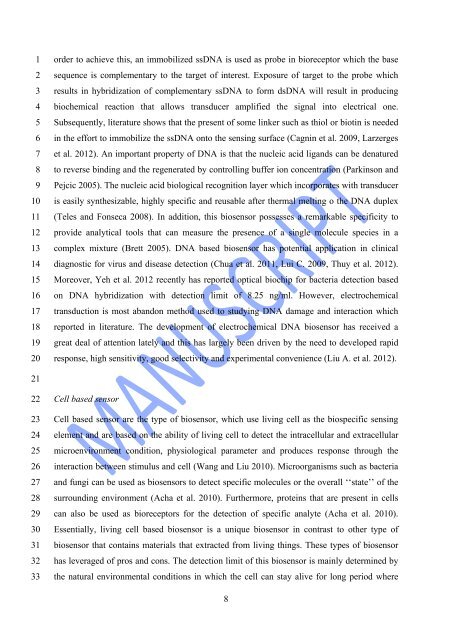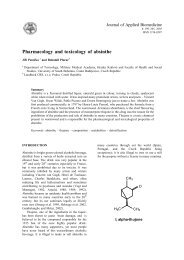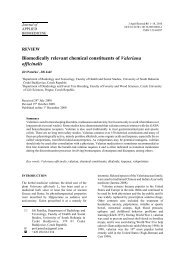Advances in biosensors: principle, architecture and applications
Advances in biosensors: principle, architecture and applications
Advances in biosensors: principle, architecture and applications
Create successful ePaper yourself
Turn your PDF publications into a flip-book with our unique Google optimized e-Paper software.
1<br />
2<br />
3<br />
4<br />
5<br />
6<br />
7<br />
8<br />
9<br />
10<br />
11<br />
12<br />
13<br />
14<br />
15<br />
16<br />
17<br />
18<br />
19<br />
20<br />
21<br />
22<br />
23<br />
24<br />
25<br />
26<br />
27<br />
28<br />
29<br />
30<br />
31<br />
32<br />
33<br />
order to achieve this, an immobilized ssDNA is used as probe <strong>in</strong> bioreceptor which the base<br />
sequence is complementary to the target of <strong>in</strong>terest. Exposure of target to the probe which<br />
results <strong>in</strong> hybridization of complementary ssDNA to form dsDNA will result <strong>in</strong> produc<strong>in</strong>g<br />
biochemical reaction that allows transducer amplified the signal <strong>in</strong>to electrical one.<br />
Subsequently, literature shows that the present of some l<strong>in</strong>ker such as thiol or biot<strong>in</strong> is needed<br />
<strong>in</strong> the effort to immobilize the ssDNA onto the sens<strong>in</strong>g surface (Cagn<strong>in</strong> et al. 2009, Larzerges<br />
et al. 2012). An important property of DNA is that the nucleic acid lig<strong>and</strong>s can be denatured<br />
to reverse b<strong>in</strong>d<strong>in</strong>g <strong>and</strong> the regenerated by controll<strong>in</strong>g buffer ion concentration (Park<strong>in</strong>son <strong>and</strong><br />
Pejcic 2005). The nucleic acid biological recognition layer which <strong>in</strong>corporates with transducer<br />
is easily synthesizable, highly specific <strong>and</strong> reusable after thermal melt<strong>in</strong>g o the DNA duplex<br />
(Teles <strong>and</strong> Fonseca 2008). In addition, this biosensor possesses a remarkable specificity to<br />
provide analytical tools that can measure the presence of a s<strong>in</strong>gle molecule species <strong>in</strong> a<br />
complex mixture (Brett 2005). DNA based biosensor has potential application <strong>in</strong> cl<strong>in</strong>ical<br />
diagnostic for virus <strong>and</strong> disease detection (Chua et al. 2011, Lui C. 2009, Thuy et al. 2012).<br />
Moreover, Yeh et al. 2012 recently has reported optical biochip for bacteria detection based<br />
on DNA hybridization with detection limit of 8.25 ng/ml. However, electrochemical<br />
transduction is most ab<strong>and</strong>on method used to study<strong>in</strong>g DNA damage <strong>and</strong> <strong>in</strong>teraction which<br />
reported <strong>in</strong> literature. The development of electrochemical DNA biosensor has received a<br />
great deal of attention lately <strong>and</strong> this has largely been driven by the need to developed rapid<br />
response, high sensitivity, good selectivity <strong>and</strong> experimental convenience (Liu A. et al. 2012).<br />
Cell based sensor<br />
Cell based sensor are the type of biosensor, which use liv<strong>in</strong>g cell as the biospecific sens<strong>in</strong>g<br />
element <strong>and</strong> are based on the ability of liv<strong>in</strong>g cell to detect the <strong>in</strong>tracellular <strong>and</strong> extracellular<br />
microenvironment condition, physiological parameter <strong>and</strong> produces response through the<br />
<strong>in</strong>teraction between stimulus <strong>and</strong> cell (Wang <strong>and</strong> Liu 2010). Microorganisms such as bacteria<br />
<strong>and</strong> fungi can be used as <strong>biosensors</strong> to detect specific molecules or the overall ‘‘state’’ of the<br />
surround<strong>in</strong>g environment (Acha et al. 2010). Furthermore, prote<strong>in</strong>s that are present <strong>in</strong> cells<br />
can also be used as bioreceptors for the detection of specific analyte (Acha et al. 2010).<br />
Essentially, liv<strong>in</strong>g cell based biosensor is a unique biosensor <strong>in</strong> contrast to other type of<br />
biosensor that conta<strong>in</strong>s materials that extracted from liv<strong>in</strong>g th<strong>in</strong>gs. These types of biosensor<br />
has leveraged of pros <strong>and</strong> cons. The detection limit of this biosensor is ma<strong>in</strong>ly determ<strong>in</strong>ed by<br />
the natural environmental conditions <strong>in</strong> which the cell can stay alive for long period where<br />
8





